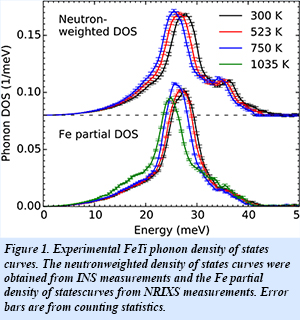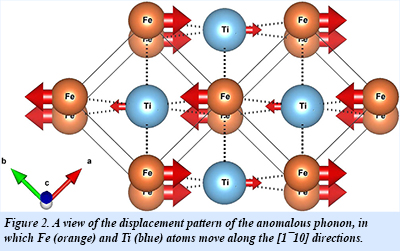 The Caltech team has shown using computational theory as well as x-ray and neutron scattering scattering measurements that FeTi undergoes an unusual change in phonon dynamics associated with changes in its electronic properties at high temperatures. The effort included EFree-supported student Sally Tracy and EFree Partner Brent Fultz.
The Caltech team has shown using computational theory as well as x-ray and neutron scattering scattering measurements that FeTi undergoes an unusual change in phonon dynamics associated with changes in its electronic properties at high temperatures. The effort included EFree-supported student Sally Tracy and EFree Partner Brent Fultz.
FeTi is a thermodynamically stable nonmagnetic intermetallic compound and a melting point of approximately 1600 K. The material is of interest for its hydrogen absorption capabilities and for its mechanical properties.
The results show an anomalous thermal softening of particular mode in FeTi that cannot be explained by phonon-phonon interactions or electron-phonon interactions calculated at low temperatures. The computations showed that the Fermi surface of FeTi undergoes a novel thermally driven electronic topological transition, in which new features of the Fermi surface arise at elevated temperatures.
 Nuclear resonant inelastic x-ray scattering (NRIXS) measurements at APS, Sector 16 (HPCAT) as well as inelastic neutron scattering at SNS were used to probe the phonon dynamics. The work illustrates both the importance of synergy between theory and experiment, and in particular the use of multiple scattering techniques, for understanding the coupling of phonons and electronic properties of materials in extreme environments.
Nuclear resonant inelastic x-ray scattering (NRIXS) measurements at APS, Sector 16 (HPCAT) as well as inelastic neutron scattering at SNS were used to probe the phonon dynamics. The work illustrates both the importance of synergy between theory and experiment, and in particular the use of multiple scattering techniques, for understanding the coupling of phonons and electronic properties of materials in extreme environments.
The work was supported by multiple DOE-BES sources, DOE-NNSA, NSF, and SNIC [F. Yang et al, Phys. Rev. Lett. 117, 076402 (2016)].
